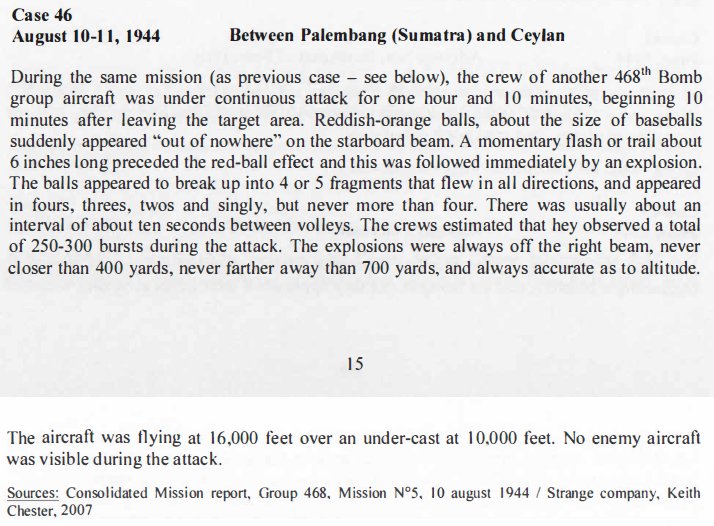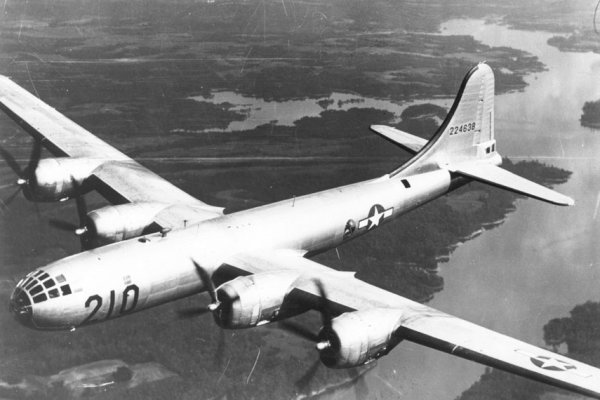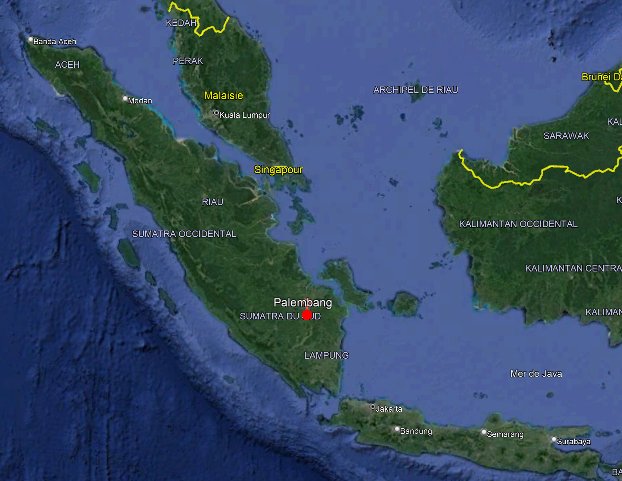ACUFO-1944-08-10-PALEMBANG-2
In 2009, French ufologist Dominique Weinstein noted in his “Foo-Fighters” sightings catalogue a case he indicated to have been published in the 2007 book “Strange Company - Military Encounters with UFOs in World War II”, by Keith Chester, the latter citing the Consolidated Mission report of Group 468, for Mission No 5 of August 10, 1944.
Weinstein's summary indicated that on August 10-11, 1944, between Palembang in Sumatra and Ceylon, during the same mission where a previous sighting had occurred, the crew of another 468th Bomb Group aircraft was under continuous attack for one hour and 10 minutes, beginning 10 minutes after leaving the target area. Reddish-orange balls, about the size of baseballs suddenly appeared “out of nowhere” on the starboard beam. A momentary flash or trail about 6 inches long preceded the red-ball effect and this was followed immediately by an explosion. The balls appeared to break up into 4 or 5 fragments that flew in all directions, and appeared in fours, threes, twos and singly, but never more than four. There was usually about an interval of about ten seconds between volleys. The crews estimated that they observed a total of 250-300 bursts during the attack. The explosions were always off the right beam, never closer than 400 yards, never farther away than 700 yards, and always accurate as to altitude. The aircraft was flying at 16,000 feet over an under-cast at 10,000 feet.
No enemy aircraft had been visible during the attack.
| Date: | August 10-11, 1944 |
|---|---|
| Time: | Night. |
| Duration: | 01:10 |
| First known report date: | 1944 |
| Reporting delay: | Hours. |
| Country: | Indonesia |
|---|---|
| State/Department: | |
| City or place: | Palembang |
| Number of alleged witnesses: | Several. |
|---|---|
| Number of known witnesses: | ? |
| Number of named witnesses: | 0 |
| Reporting channel: | Military operations report, UFO book Keith Chester. |
|---|---|
| Visibility conditions: | Night. |
| UFO observed: | Yes. |
| UFO arrival observed: | Yes. |
| UFO departure observed: | Yes. |
| UFO action: | Explode in several fragments. |
| Witnesses action: | |
| Photographs: | No. |
| Sketch(s) by witness(es): | No. |
| Sketch(es) approved by witness(es): | No. |
| Witness(es) feelings: | ? |
| Witnesses interpretation: | ? |
| Sensors: |
[X] Visual: Several.
[ ] Airborne radar: [ ] Directional ground radar: [ ] Height finder ground radar: [ ] Photo: [ ] Film/video: [ ] EM Effects: [ ] Failures: [ ] Damages: |
|---|---|
| Hynek: | NL |
| Armed / unarmed: | Armed, 12 Browning M2 12.7 mm machine guns. |
| Reliability 1-3: | 2 |
| Strangeness 1-3: | 1 |
| ACUFO: | Possible ground to air rockets. |
[Ref. dwn2:] DOMINIQUE WEINSTEIN:

|
During the same mission (as previous case - see below), the crew of another 468th Bomb group aircraft was under continuous attack for one hour and 10 minutes, beginning 10 minutes after leaving the target area. Reddish-orange balls, about the size of baseballs suddenly appeared “out of nowhere” on the starboard beam. A momentary flash or trail about 6 inches long preceded the red-ball effect and this was followed immediately by an explosion. The balls appeared to break up into 4 or 5 fragments that flew in all directions, and appeared in fours, threes, twos and singly, but never more than four. There was usually about an interval of about ten seconds between volleys. The crews estimated that they observed a total of 250-300 bursts during the attack. The explosions were always off the right beam, never closer than 400 yards, never farther away than 700 yards, and always accurate as to altitude. The aircraft was flying at 16,000 feet over an under-cast at 10,000 feet. No enemy aircraft was visible during the attack.
Sources: Consolidated Mission report, Group 468, Mission No 5, 10 august 1944 / Strange company, Keith Chester, 2007
[Ref. sua1:] WEBSITE "SATURDAY NIGHT UFORIA":
The author gives an example of American pilots' reports in the Pacific of what may or may not have been what Allied pilots in Europe called "foofighters", with the following tactical mission report of mission of the August 10 and 11, 1944, over Sumatra:
Observations were reported by several crews regarding a bizarre and confusing type of new weapon, probably of the rocket type. In some cases, crews believe the projectiles were ground released, but analysis of reports and further interrogation indicate that ground release was virtually impossible because of the unlikelihood of ground installations at many of the points where observations were made, and because of the fact that the attacks followed our aircraft continuously over great distances and in some cases out over water. Conversely, no enemy aircraft were sighted during the time of the attacks. Because of the need for clarification and identification of the weapon, crew reports are covered in detail below:
a. One aircraft was under continuous attack for 1 hour and 10 minutes, beginning 10 minutes after leaving the target area. Reddish-orange balls about the size of baseballs suddenly appeared "out of nowhere" on the starboard beam; a momentary flash or trail about 6 inches long preceded the red-ball effect and this was followed immediately by an explosion. The balls appeared to break up into 4 or 5 fragments that flew in all directions and appeared in fours, threes, twos, and singly, but never more than 4 appeared at the same time. There was usually about an interval of about ten seconds between volleys. The crews estimated that they observed a total of 250-300 separate bursts during the attack. The explosions were always off the right beam, never closer than 400 yards, never further away than 700 yards, and always accurate as to altitude. The aircraft was flying at 16,000 feet over an under-cast at 10,000 feet varying from 5/10 to 10/10. Lateral visibility was estimated as 30 miles except for occasional scattered clouds, but no enemy aircraft were sighted. There were no ground flashes observed when the ground was visible. Bursts were not observed when the aircraft flew through clouds, but reappeared when the clouds were passed.
On one occasion, the course was altered sufficiently to allow tail guns to bear in the direction of the bursts, but 20-mm and 50-cal. fire from the B-29 had no visible effect. There was no change in the continuity of characteristics of the bursts when our aircraft reached the west coast of Sumatra and flew out over the Indian Ocean. The explosions continued until after Siberoet island had been passed. There was no clue as to whether the projectiles were originating from below, level, or above. The B-29 was not damaged.
The extreme strangeness of the event speaks for itself and it can only be imagined what thoughts were racing through the minds of the air crew over the course of the seventy minutes that this encounter took place. The use of the terms 'continuous attack' and 'explosions' is confounding, particularly since "the B-29 was not damaged" and there is no report of concussion -- could it have been just the best available terms fitting the weird circumstances when experienced in the midst of a combat mission in the Pacific? That question, of course, is unanswerable and illustrates the difficulty of discerning which is conventional and which is not, when reviewing reports from the Pacific air war.
[Ref. tai1:] "THINK ABOUT IT" WEBSITE:
Date: Aug. 10/11, 1944
Location: Palembang, Sumatra
Time:
Summary: Reddish orange balls, about the size of a baseball; spherical object, probably 5 or 6 feet in diameter, of a very bright and intense red or orange in color.
Page 71-74 Ref.1
[Ref. fjh1:] FRANK JOSEPH:
A somewhat similar confrontation took place the night of August 10-11 that same year on the other side of the world, but with different results. First Officer Russell Watson was piloting a B-29 Superfortress, number 6362, on its return flight from a combined raid of the 20th Air Force on the Pladjoe oil refinery at Palembang, Sumatra. In his report to the 20th Bomber Command's air-intelligence section, he stated that his and “several bomber crews” observed what they believed was
a bizarre and confusing type of new weapon... One aircraft was under continuous attack for 1 hour and 10 minutes, beginning 10 minutes after leaving the target area. Reddish-orange balls about the size of baseballs suddenly appeared “out of nowhere” on the starboard beam; a momentary flash or trail about 6 inches long preceded the red-ball effect and this was followed immediately by an explosion.
The balls appeared to break up into 4 or 5 fragments that flew in all directions, and appeared in fours, threes, twos, and singly, but never more than 4 appeared at the same time. There was usually about an interval of about ten seconds between volleys. The crews estimated that they observed a total of 250-300 separate bursts during the attack. The explosions were always off the right beam, never closer than 400 yards, never father away than 700 yards, and always accurate as to altitude.
On one occasion, the course was altered sufficiently to allow tail guns to bear in the direction of the bursts, but 20-mm and 50-cal. fire from the B-29 had no visible effect... The B-29 was not damaged.
The Boeing B-29 “Superfortress” was the heaviest bomber of the U.S. Army Air Forces, used in operations from May 8, 1944 and on. Its maximum speed was 574 km/h.
Its defensive armament was 12 Browning M2 12.7 mm machine guns.

|

|
I am very tempted to think that there was no extraterrestrial spacecraft there, but the use by the Japanese of anti-aircraft rockets. What is described in fact strongly resembles a fireworks display, nothing like the “classic Foo-Fighters” who accompany the flight of planes, maneuver to follow planes performing evasive action, etc.
It is a known fact that the Japanese sometimes dropped air-to-air phosphorus bombs from their planes, from above, on the B-29s. It doesn't seem to be that in this case since no enemy planes were seen, which is why I think more of rockets coming from the ground. It is historically known that the Japanese fired such rockets, similar mission reports from 1945 are full of them, but it was still quite new in 1944 for B-29 pilots.
One problem with my explanation is the duration, since we are told that the attack lasted an hour and ten minutes, after the B-29 left the target area. In such a time interval, the B-29 would have quickly been out of range of such anti-aircraft defenses, which one cannot imagine had been lined up along such a long route of the B-29.
For my explanation to hold, it is therefore necessary either that this duration was an error in reading the original report, or that the plane in question was missioned to remain in the area to photograph the damage caused by the raid.
Furthermore, I do not understand how the plane could have been under this fire for 1 hour 10 without any damage being reported.
Possible ground to air rockets.
* = Source is available to me.
? = Source I am told about but could not get so far. Help needed.
| Main author: | Patrick Gross |
|---|---|
| Contributors: | None |
| Reviewers: | None |
| Editor: | Patrick Gross |
| Version: | Create/changed by: | Date: | Description: |
|---|---|---|---|
| 0.1 | Patrick Gross | December 30, 2023 | Creation, [dwn2], [tai1]. |
| 1.0 | Patrick Gross | December 30, 2023 | First published. |
| 1.1 | Patrick Gross | February 1, 2024 | Addition [fjh1]. |
| 1.2 | Patrick Gross | July 9, 2024 | Addition [sua1]. |